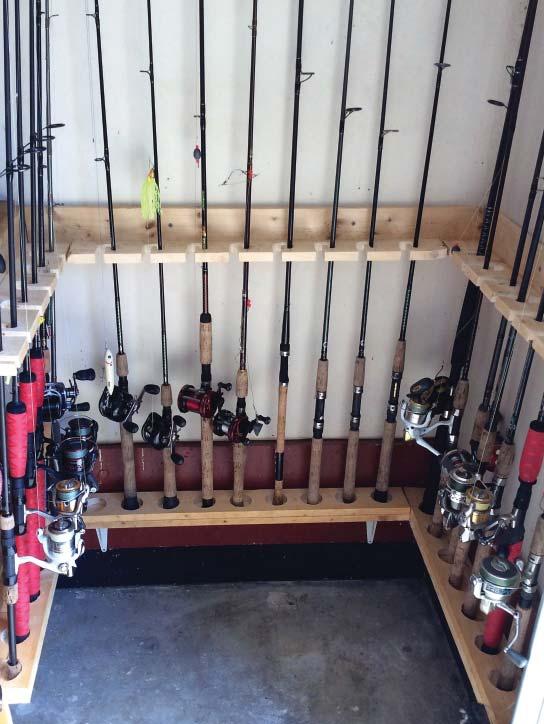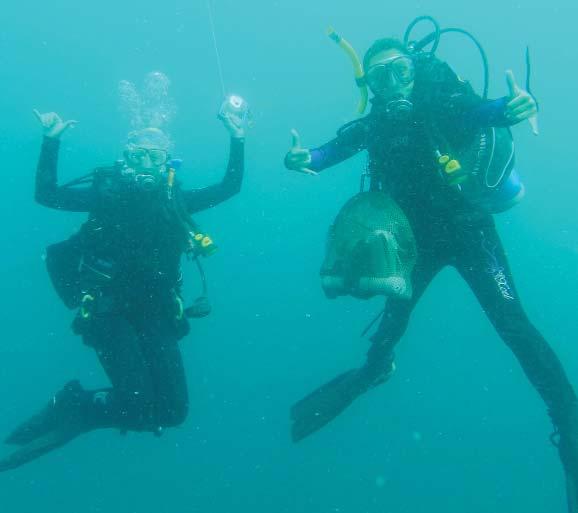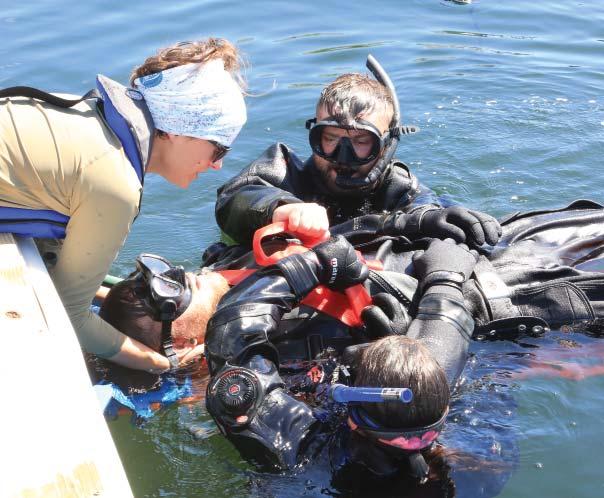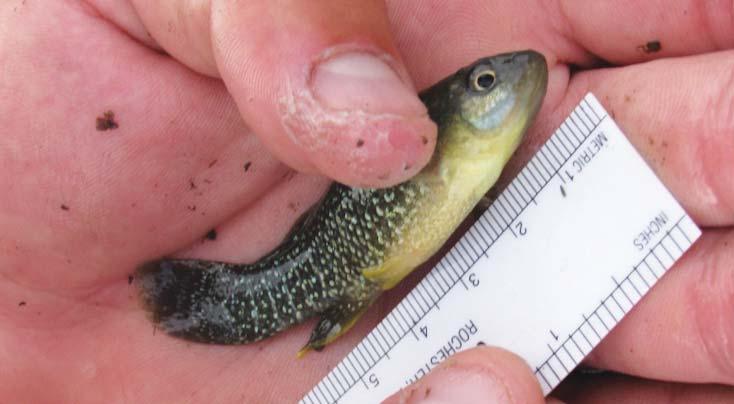
8 minute read
9 Ebb & Flow - The Spring Roar
The Spring Roar
By Trey Leggett
Advertisement
Although Punxsutawney Phil advised that we have six more weeks of winter, March is still the time for St. Patrick’s Day, green beer, azalea blooms, turkey hunting, and last-ditch eff orts to get ready for full blown fi shing season.
Typically, fi shermen use the months of January through March to get ready for warmer weather fi shing, even if they fi sh all year round. This is the perfect time for boat and kayak deep cleaning and rigging of rod holders, tackle storage, motor maintenance, and electronics installations.
Boat Work
• Although I fi sh all during the year, I go through my boat and kayak from front to back, cleaning and making sure I have all the regulated equipment (like throwables, life jackets, ropes, fi re extinguishers, etc.) onboard and in proper working order. • I check my trailer lights, bolts, tires, and wheel hubs for functionality and perform whatever maintenance is required. • This is a good time for adding items of convenience like rod holders and better tackle storage to keep items secure and readily available. A cluttered fi shing vessel is aggravating and unsafe. • Even if you have motor maintenance done when you get to the required hours, you can still check your propeller and lower unit for any damage. • Checking your battery is a must; recharge or replace if needed. Being stranded and having to call for a tow is no fun.
Fishing Gear
Late winter is also a great time to clean, repair, or replace your fi shing equipment. • A smooth fi shing reel is a must when casting and reeling in fi sh. Make sure dust, sand, and other foreign objects are cleaned from your reels. Check and/or replace drag washers or brakes, depending on what type of reel you have. • Check your fi shing rods for any bad eyelets that can cut your line or diminish the performance of your rod. Replacing eyelets is relatively easy, or you can get a repair person to do it at minimal cost.
Fishing Rods are ready! Photo by Trey Leggett
• Check your fi shing line and replace if necessary. Braided lines are very durable and can be used for a long time. I've been known to unspool my braid and spool it back on, backwards, so I can use the line I haven’t used much previously. • Inventory lures, leader material, hooks, weights, popping corks, and other tackle items. Having needed items on hand is a must on any successful fi shing trip. • Take the time to replace or sharpen hooks on lures. Losing a fi sh to a broken or dull hook isn’t fun.
I believe 2018 is going to be a great fi shing year for our area and I hope you all have great success! Stay informed of current fi shing regulations, weather reports, fi shing reports, and any fun fi shing tournaments in your area. Don’t forget, kids love fi shing and it gets them out of the house and off the video games, so take a kid fi shing!
Stay safe and tight lines.
Trey fi shes for Hobie Polarized Sunglasses, and ENGEL Coolers. Email: info@southerntidesmagazine.com
By Michelle Riley
Communications & Public Outreach Coordinator Gray’s Reef National Marine Sanctuary
Gray’s Reef National Marine Sanctuary’s vessel operations coordinator, lieutenant junior grade Marybeth Head, holds the same rank in NOAA Corps, which is a uniform service under the Department of Commerce. It is the operational arm of the National Oceanic and Atmospheric Administration (NOAA), and NOAA Corps offi cers can be seen scattered throughout the country, undertaking all sorts of diff erent missions. These offi cers can serve as hurricane hunting pilots fl ying P-3 Orion aircraft, or commanders of NOAA ships around the fl eet, or as divers, hydrographers and scientists throughout every part of NOAA.
That said, boats usually are the primary focus of most NOAA Corps offi cers, and Marybeth is no exception. She considers her role at Gray’s Reef an organic fi t, since the sanctuary has two boats, the R/V Sam Gray and the R/V Joe Ferguson. However, since the offi ces are on land, NOAA Corps considers her work with the sanctuary a “land assignment” between sea tours. Handling the Gray’s Reef vessels alongside Captain Todd Recicar keeps Marybeth’s skills sharp, while planning and managing operations helps her develop those abilities. She also works closely with Gray’s Reef’s research coordinator, Kim Roberson. Marybeth often dives with Kim to change out the acoustic receivers from the sanctuary’s ongoing fi sh tagging program, or conducts scientifi c surveys with Kim and other scientists. Marybeth also is an integral member of the science diving team that conducts the annual NOAA Ship Nancy Foster research expedition in the sanctuary each summer.
Last month, Marybeth received her NOAA Divemaster certifi cation, which is the fi rst step in diving leadership. She is pleased to have learned a new skill set. “I was very excited about this certifi cation, because I hope to get a shot at serving as the Executive Offi cer at the NOAA Diving Center someday,” she said.
The NOAA Divemaster class is psychologically challenging because the students learn to be eff ective in accident management. One of Marybeth’s favorite lessons is a simulated drill in which the divemaster has no advance knowledge of the circumstances. During the simulation, the divemaster must quickly and correctly assess the situation, take control of the scene and secure the rescue and survival of the divers. Marybeth observes, “Everyone can think they know what to do in an emergency, but you don’t really know for sure until you do well-planned drills.”
NOAA Corps will assign Marybeth to her next billet in about 18 months, but until then, she’ll continue to enjoy her time at Gray’s Reef and in Savannah. With a smile and a nod, she asks, “How lucky am I, that I get to serve my land assignment in such a beautiful place, with one of the most pristine national marine sanctuaries off its coast?”

Above: NOAA Corp Ensign Sara Thompson (left) and LTJG Marybeth (right). Photo by Kimberly Roberson/ GRNMS
Right: Marybeth in uniform. Photo by Michelle Riley/GRNMS
Below: DiveMaster class,
February 2018. Photo by Patrick Vandenabeele/ NOAA


Did You Know? Taste of the Tides
The word “mummichog” is a Native American word meaning “going in crowds” which is the perfect name for this little fish as they are often found in crowds of over 100 individuals.
Savory Grouper with Lemon Cream Sauce
By Amy Thurman

• The mummichog (Fundulus heteroclitus) is a small fi sh found in the tidal creeks and muddy pools of protected bays and estuaries. These hardy little fi sh are specially adapted to live in this everchanging environment. • One of their super powers is that they do not need very much oxygen to survive. This comes in handy when they get trapped on the surface of the salt marsh as the tide goes out. Mummichogs simply burrow themselves into the mud and wait a few hours for the next tide to come rolling back in. • A type of killifish, females lay their eggs in empty ribbed mussel shells in the high marsh, even in areas neap tides don't reach. Hatchlings and small fish stay in the high marsh and ride out low tides in tiny pools of water, shells, even raccoon paw prints. They remain in this predator-free area until they grow a bit, then move into tidal creeks. • Mummichogs (fishermen often refer to them as pollywogs) can grow to about five inches in length which makes them the perfect size for bait. They are found in coastal waters from Mexico to Canada. • Mummichogs are not very picky eaters and are known to eat both plants and small animals. In fact, Mummichogs are able to eat up to 2,000 mosquito larvae in a single day, so some people use them as a method of natural mosquito control.
Data compiled by Christine Burns, University of Georgia Sources included John Crawford, ChesapeakeBay.net and gma.org Photo above by Robin Baranowski/NPS Photo below by Brian Gratwicke, via Wikimedia
We've had several requests for fi sh recipes, so here you go! I picked up fresh grouper from Ken's Seafood in Richmond Hill, but any solid local fi sh will work.
INGREDIENTS
Fresh fish filets, enough for two to four people 2 tablespoons olive oil Garlic powder, onion powder, paprika, and black pepper 1 whole fresh lemon 3/4 cup heavy whipping cream 2 tablespoons chopped fresh cilantro (or parsley if you don't like cilantro) 1/4 teaspoon salt
DIRECTIONS
•Rinse fi lets and pat dry, then sprinkle with garlic, onion, paprika and black pepper, to taste. •Pour olive oil in non-stick skillet and set to medium heat. When skillet is hot, place fi lets seasoning side down, then season the tops with the same spices. •Cook fi sh just until done, about three minutes per side, depending on thickness of fi lets. Reduce heat as needed to avoid scorching. •While fi sh is cooking, wash the lemon and grate the peel from half of it. Cut lemon in half, then cut the ungrated half into slices. Retain the grated half. •When fi sh is golden brown on both sides, remove to serving plates. •Return skillet to medium heat and add lemon zest, then heavy cream. •Bring to simmer, stirring with whisk, until sauce begins to thicken, usually about two minutes. •Add cilantro, salt, and squeeze juice from the grated lemon half into the mixture, then whisk another two minutes. •Distribute cream sauce evenly over fi sh, serve with lemon slices.


March 2018 Southern Tides Magazine 13 Enjoy!









